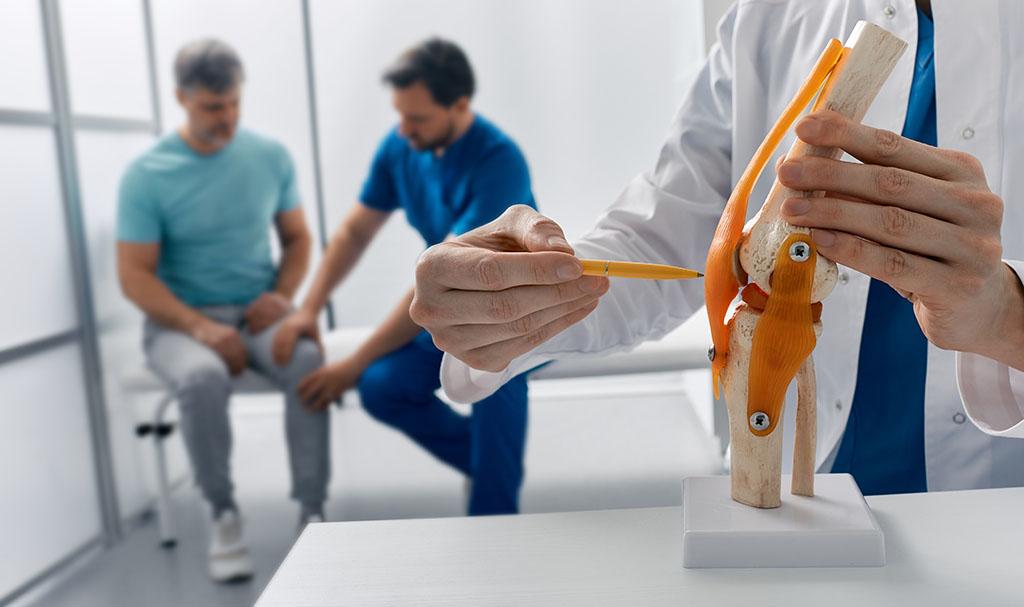What You Need to Know About the Ligaments in the Knee

May 2023
Your knees are crucial in supporting you in your everyday activities. They are complex joints that play a vital role in our ability to walk run and engage in various physical activities. The knee has a complex and delicate anatomy and is supported and stabilized by a network of ligaments that connect to your lower leg bones to provide structural integrity.
Sprained knee ligaments can happen for various reasons, but are more common among athletes who participate in sports that involve quick changes in direction, such as gymnastics, football and martial arts.
People who have previously experienced a knee ligament injury, such as an ACL tear, are at a greater risk of reinjury. Once a ligament has been damaged, the knee joint may become more vulnerable to future injuries.
Knee ligament injuries can vary from mild to severe, and there are non-surgical treatments to help manage and heal these injuries.
Anatomy of the Knee Ligaments
The knee joint is comprised of four primary ligaments that work together to provide stability and allow for smooth movement:
- Anterior cruciate ligament (ACL): The ACL is located at the center of the knee and prevents the tibia (shinbone) from sliding forward in relation to the femur (thighbone). It also helps stabilize rotational movements of the knee.
- Posterior cruciate ligament (PCL): The PCL is situated opposite the ACL and prevents the tibia from sliding backward in relation to the femur. It plays a crucial role in stabilizing the knee joint and preventing hyperextension.
- Medial collateral ligament (MCL): The MCL is located on the inner side of the knee and provides stability against forces pushing the knee inward. It also helps prevent excessive rotation of the knee.
- Lateral collateral ligament (LCL): The LCL is positioned on the outer side of the knee and provides stability against forces pushing the knee outward. It also assists in limiting rotation of the knee.
Functions of the Knee Ligaments
- Stability: The ligaments work as stabilizers to prevent excessive movement of the knee joint, ensuring it stays aligned and functions optimally during various activities.
- Range of motion control: While the ligaments restrict certain movements, they also allow for a wide range of motion, enabling activities like walking, running, jumping and bending of the knee.
- Force distribution: By distributing forces evenly across the knee joint, the ligaments help protect the bones, cartilage and other structures from excessive stress and potential damage.
Common Knee Ligament Injuries
An injured knee ligament is called a sprain or a tear and usually affects one or more primary ligaments. These conditions usually leave injured patients with short-term or chronic pain, swelling and instability depending on the severity of the injury. In some cases, the symptoms may only manifest in specific circumstances.
Common types of knee ligament injuries include:
- ACL tear: An ACL tear is a common sports injury that occurs when the ACL is stretched or torn, often due to sudden stops, twisting motions or direct impact to the knee. Patients may feel as if their knee can’t safely bear their weight.
- MCL tear: An MCL tear is typically caused by a direct blow to the outer side of the knee or a force that pushes the knee inward. Patients commonly have difficulty straightening their leg after an MCL tear.
- PCL tear: PCL tears often occur due to a forceful impact to the front of the knee or hyperextension. Symptoms often manifest most acutely when the injured person is walking or climbing stairs.
- LCL tear: LCL tears are less common than other ligament injuries and usually result from a force that pushes the knee inward. In many cases the symptoms are localized or more severe on the outside of the knee.
How Are Knee Ligament Injuries Treated
Treatment options range from simple at-home remedies to invasive surgical interventions. The latter can usually be avoided as long as you’re consistently following a prescribed treatment regimen prescribed by your doctor.
Depending on the severity of the injury, non-surgical treatments for a torn knee ligament can include:
- RICE, which stands for rest, ice, compression and elevation
- Walking with the help of crutches to help keep weight off the knee
- Taking nonsteroidal anti-inflammatory medication like ibuprofen
- Wearing a knee brace
- Physical therapy (including water therapy)
- Regenerative medicine, including platelet rich plasma (PRP) injections
Keeping Your Knee Ligaments Healthy
Whether you’re an athlete or exercise only on occasion (or somewhere in between), you can sprain your knee ligament. Luckily, there are several ways in which you can help keep your knee ligaments strong and reduce the risk of injuries:
- Warm up and stretch: Before engaging in any physical activity, warm up your body with light exercises and stretches to prepare the muscles, tendons and ligaments for an upcoming workout.
- Wear appropriate footwear: Wear well-fitting shoes that provide adequate support and cushioning for your feet and knees, especially during activities that involve running or jumping.
- Gradually increase intensity: When starting a new exercise routine like running or riding a bike, gradually increase the intensity and duration to allow your body, including your ligaments, to adapt and strengthen over time.
- Maintain a healthy weight: Excess body weight puts added stress on your knee joints and ligaments. Maintaining a healthy weight reduces the strain on these structures and lowers the risk of injury.
- Listen to your body: Pay attention to any pain, discomfort or swelling in your knees, as these may be signs of a torn knee ligament. If you experience persistent symptoms, see a doctor who can diagnose and address underlying issues promptly.
Find the Right Non-Surgical Knee Ligament Injury Treatment for You
At Non-Surgical Orthopaedics, we help people with knee injuries and various other orthopaedic injuries find relief from pain while we implement a variety of non-surgical treatment methods to promote optimal healing.
Not all knee ligament injuries can improve with only rest and over-the-counter medication. Our team of specialists will take the time to examine your symptoms and recommend a personalized treatment plan for your unique situation.
To learn more about our non-surgical therapies or to make an appointment at our Carrollton or Marietta location, call 770-421-1420.






